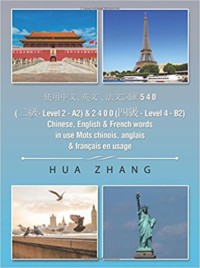Title: Chinese, English and French Words in Use 使用中文 、英文 、法文詞匯 5 4 0 (二級 – Level 2 – A2) & 2 4 0 0 (四級 – Level 4 – B2)
Author: Hua Zhang
Publisher: AuthorHouseUK
ISBN: 9781524668075
Pages: 206
Genre: Education, Non-Fiction
Reviewed by: Barbara Bamberger Scott
Pacific Book Review
Hua Zhang, a professor specializing in cross cultural English and Chinese pedagogy, has composed a remarkable dictionary for use in studying idiomatic expressions in three languages— Chinese, English and French.
The author, with a degree in foreign language from the Beijing Foreign Language Study University, intends this book, part of a series, for those needing to enhance their vocabularies. The practical value of his method is that it allows native speakers of any of the three languages to learn common expressions in the other two. Both English and French can be vitally important for Chinese speakers who want to work abroad or with international companies. In this manual, the student can build upon his/her knowledge of one or two languages to understand the third.
In a brief introduction, the author explains the different stages of learning (his numerical system of lessons) expressing his belief that it is possible to “master the 2 or 4 vocabularies at one time” by starting with the simplest example. Thus his guide begins with a single word in Chinese (both characters and Anglicized spelling), followed by a sentence expressing that word or phrase in English and then French.
The manual itself consists of nearly 200 pages of words and phrases arranged in English alphabetical order. Since this book is part of a series, each item begins with vocabularies from 2 previous levels. An example from the lexicon would be the Chinese word—expressed in English characters—biàn, with the English translation given as, “The situation has changed,” and the French as, “La situation a changé.” Some Chinese words have more than one meaning, so biàn can also be rendered as “They have travelled all over the country,” or in French, “Illes sont allés partout dans le pays.” The Chinese word làngfèi is presented in English as “How you waste things!” and in the French, “Qu’est-ce que tu gaspilles!” The value of this method to those studying any one of the three languages is easy to imagine. A French speaking person studying English could use the listings to learn that “le ciel est tout bleu” would be pretty simple in English: “The sky is entirely blue.”
Another aspect of the dictionary-style study technique presented here is that those students speaking either English or French and needing to travel or work in China, (a practice becoming increasingly common) could use this organized list to figure out some common Chinese symbols or grasp useful phrases for ordinary conversation. The author has clearly made a significant effort to facilitate language study, including a list of dictionaries and other reference books used in the book’s creation.
Chinese, English and French Words in Use 使用中文 、英文 、法文詞匯 5 4 0 (二級 – Level 2 – A2) & 2 4 0 0 (四級 – Level 4 – B2) is a practical study tool for anyone seeking bi- or tri-lingual proficiency at a basic or intermediate level. This book is very well written and organized. I cannot recommend this book series enough. Hua Zhang delivers in a concise, easy-to-study format.


